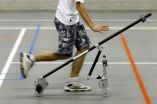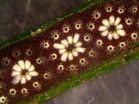(Press-News.org) Stephen Spielberg's movie Jurassic Park got one thing right.
Velociraptors hunted by night while big plant-eating dinosaurs browsed around the clock, according to a paper on the eyes of fossil animals published on-line this week in Science Express.
That overturns the conventional wisdom that dinosaurs were active by day while early mammals scurried around at night, said Ryosuke Motani, a geologist at the University of California at Davis, and a co-author of the paper.
"It was a surprise, but it makes sense," Motani said.
It's also providing insight into how ecology influences the evolution of animal shape and form over tens of millions of years, according to Motani and collaborator Lars Schmitz, a postdoctoral researcher at UC Davis.
"These authors' conclusion that these dinosaurs were active diurnally and nocturnally challenges a general dogma--that nocturnality in that time was mostly restricted to mammals," says H. Richard Lane, program director in the National Science Foundation (NSF)'s Division of Earth Sciences, which funded the research.
Motani and Schmitz worked out the dinosaurs' daily habits by studying their eyes.
Dinosaurs, lizards and birds all have a bony ring called the "scleral ring" in their eyes, although this is lacking in mammals and crocodiles.
Schmitz and Motani measured the inner and outer dimensions of this ring, plus the size of the eye socket, in 33 fossils of dinosaurs, ancestral birds and pterosaurs--and in 164 living species.
Day-active, or diurnal animals have a small opening in the middle of the ring while the opening is much larger in nocturnal animals.
Cathemeral animals--active in both day and night--tend to be in between.
But the size of these features is also affected by ancestry.
For example, two closely related animals might have similar eye shape even if one is active by day and the other by night: the shape of the eye is constrained by ancestry, and that could bias the results.
Schmitz and Motani developed a computer program to separate the "ecological signal" from this "phylogenetic signal."
The results of that analysis are in a separate paper published simultaneously in the journal Evolution.
By looking at a 164 living species, they could confirm that the eye measurements were accurate in predicting whether animals were active by day, by night or around the clock.
Then they applied the technique to fossils, including plant-eating and carnivorous dinosaurs, flying reptiles called pterosaurs and ancestral birds.
The big plant-eating dinosaurs were active day and night, probably because they had to eat most of the time, except for the hottest hours of the day when they avoided overheating.
Modern megaherbivores like elephants show the same activity pattern, Motani said.
Velociraptors and other small carnivores were night hunters.
Schmitz and Motani were not able to study big carnivores such as Tyrannosaurus rex, because there are no fossils with sufficiently well-preserved eyes.
Flying creatures, including early birds and pterosaurs, were mostly day-active, although some of the pterosaurs--including a filter-feeding animal that probably lived like a duck, and a fish-eating pterosaur--were apparently night-active.
"This strongly suggests that ecology drives activity," Schmitz said.
By separating out the effects of ancestry, researchers now have a tool to understand how animals lived in their environment and how changes in the environment influenced their evolution over millions of years, Motani said.
###
The work was also funded a postdoctoral fellowship from the German government (DFG).
'Jurassic Park' had it right: Some dinosaurs hunted by night
New research results show that dinosaurs didn't all dine by day
2011-04-15
ELSE PRESS RELEASES FROM THIS DATE:
Boston University researchers find most substance–dependent individuals report poor oral health
2011-04-15
A team of Boston University researchers has found that the majority of individuals with substance dependence problems report having poor oral health. They also found that opioid users, in particular, showed a decline in oral health over the period of one year. These findings appear online in the Journal of Substance Abuse Treatment.
Public health, dental medicine and internal medicine faculty from Boston University investigated the affects of different substances on oral health among a sample of substance-dependent individuals. Alcohol, stimulant, opioid and marijuana ...
University of Toronto researchers 'brighten' the future of OLED technology
2011-04-15
Chlorine is an abundant and readily available halogen gas commonly associated with the sanitation of swimming pools and drinking water. Could a one-atom thick sheet of this element revolutionize the next generation of flat-panel displays and lighting technology?
In the case of Organic Light-Emitting Diode (OLED) devices, it most certainly can. Primary researchers Michael G. Helander (PhD Candidate and Vanier Canada Graduate Scholar), Zhibin Wang (PhD Candidate), and led by Professor Zheng-Hong Lu of the Department of Materials Science & Engineering at the University of ...
Why does a moving bicycle not fall over? TU Delft casts aside some old theories
2011-04-15
Given sufficient forward speed, a bicycle pushed sideways, will not fall over. Scientists have been trying to find a conclusive explanation for this remarkable characteristic for over a century. This week, researchers at Delft University of Technology (TU Delft, The Netherlands) have thrown new light on the question in a publication in Science.
Staying stable
The research at TU Delft, in collaboration with scientists from Cornell University (USA), centred on the following intriguing question: why is a bicycle self stable, above a certain speed? You add speed to a bike ...
Highest percentage of Americans in 4 decades say financial situation has gotten worse
2011-04-15
A recently released report of the General Social Survey, conducted by NORC at the University of Chicago, shows that for the first time since 1972, more Americans say that their financial situation has gotten worse in recent years rather than better. Understandably, also for the first time since 1972, the percentage of Americans saying that they are "not at all" satisfied with their financial situation (31.5%) notably exceeds those saying they are "pretty well" satisfied (23.4%).
The General Social Survey which NORC has conducted for forty years, is supported by the National ...
People who overuse credit believe products have unrealistic properties
2011-04-15
COLUMBIA, Mo. – A University of Missouri researcher says people who overuse credit have very different beliefs about products than people who spend within their means. Following a new study, Marsha Richins, Myron Watkins Distinguished Professor of Marketing in the Trulaske College of Business, says many people buy products thinking that the items will make them happier and transform their lives.
"There is nothing wrong with wanting to buy products," Richins said. "It becomes a problem when people expect unreasonable degrees of change in their lives from their purchases. ...
TBI Therapy and Nutrition: IOM report releases April 20
2011-04-15
Nutrition research is pointing to ways that nutrients or diets may lessen the effects of traumatic brain injury (TBI), raising the possibility that the U.S. Department of Defense might be able to use nutritional approaches to help personnel who receive a TBI. Nutrition and Traumatic Brain Injury: Improving Acute and Subacute Health Outcomes in Military Personnel, a new report from the Institute of Medicine, recommends which nutritional approaches DOD should adopt and priorities for further research into nutrients and diets that show promise for being effective in providing ...
Targeting top 911 callers can trim cost, improve patient care
2011-04-15
Repeated unnecessary 911 calls are a common drain on the manpower and finances of emergency medical services, but a pilot program that identified Baltimore City's top 911 callers and coupled them with a case worker has succeeded in drastically cutting the number of such calls while helping callers get proper care.
The program, called Operation Care, was conceived and implemented by the non-profit agency Baltimore HealthCare Access and ran as a three-month pilot in 2008. Now, a newly published report of its results appearing in The American Journal of Emergency Medicine ...
Studies of marine animals aim to help prevent rejection of transplanted organs
2011-04-15
(Santa Barbara, Calif.) –– Studies of the small sea squirt may ultimately help solve the problem of rejection of organ and bone marrow transplants in humans, according to scientists at UC Santa Barbara.
An average of 20 registered patients die every day waiting for transplants, due to the shortage of matching donor organs. More than 110,000 people are currently waiting for organ transplants in the U.S. alone. Currently, only one in 20,000 donors are a match for a patient waiting for a transplant.
These grim statistics drive scientists like Anthony W. De Tomaso, assistant ...
Older workers benefit from high-tech, high-touch health promotion
2011-04-15
Older workers benefit most from a modest health behavior program when it combines a web-based risk assessment with personal coaching.
University of Illinois at Chicago researchers conducted a randomized trial to evaluate two worksite wellness interventions assessing older workers' health behaviors and outcomes. The findings are available online and will be published in an upcoming issue of the American Journal of Public Health.
The health behaviors that were examined were physical activity, diet, stress reduction and smoking cessation, says Susan Hughes, professor of ...
Novel therapy improves immune function in teen with rare disease
2011-04-15
In a novel approach that works around the gene defect in Wiskott-Aldrich syndrome, an inherited immune deficiency disorder, researchers used an alternative cell signaling pathway to significantly improve immune function in a 13-year-old boy with the disease. The study, at The Children's Hospital of Philadelphia, provides a proof-of-principle that immunotherapy, which harnesses elements of the body's immune system, may be used to treat this rare but often deadly disorder.
"If this encouraging initial result holds up in further ...
LAST 30 PRESS RELEASES:
Reviving dormant immunity: Millimeter waves reprogram the immunosuppressive microenvironment to potentiate immunotherapy without obvious side effects
Safety decision-making for autonomous vehicles integrating passenger physiological states by fNIRS
Fires could emit more air pollution than previously estimated
A new way to map how cells choose their fate
Numbers in our sights affect how we perceive space
SIMJ announces global collaborative book project in commemoration of its 75th anniversary
Air pollution exposure and birth weight
Obstructive sleep apnea risk and mental health conditions among older adults
How talking slows eye movements behind the wheel
The Ceramic Society of Japan’s Oxoate Ceramics Research Association launches new international book project
Heart-brain connection: international study reveals the role of the vagus nerve in keeping the heart young
Researchers identify Rb1 as a predictive biomarker for a new therapeutic strategy in some breast cancers
Survey reveals ethical gaps slowing AI adoption in pediatric surgery
Stimulant ADHD medications work differently than thought
AI overestimates how smart people are, according to HSE economists
HSE researchers create genome-wide map of quadruplexes
Scientists boost cell "powerhouses" to burn more calories
Automatic label checking: The missing step in making reliable medical AI
Low daily alcohol intake linked to 50% heightened mouth cancer risk in India
American Meteorological Society announces Rick Spinrad as 2026 President-Elect
Biomass-based carbon capture spotlighted in newly released global climate webinar recording
Illuminating invisible nano pollutants: advanced bioimaging tracks the full journey of emerging nanoscale contaminants in living systems
How does age affect recovery from spinal cord injury?
Novel AI tool offers prognosis for patients with head and neck cancer
Fathers’ microplastic exposure tied to their children’s metabolic problems
Research validates laboratory model for studying high-grade serous ovarian cancer
SIR 2026 delivers transformative breakthroughs in minimally invasive medicine to improve patient care
Stem Cell Reports most downloaded papers of 2025 highlight the breadth and impact of stem cell research
Oxford-led study estimates NHS spends around 3% of its primary and secondary care budget on the health impacts of heat and cold in England
A researcher’s long quest leads to a smart composite breakthrough
[Press-News.org] 'Jurassic Park' had it right: Some dinosaurs hunted by nightNew research results show that dinosaurs didn't all dine by day

